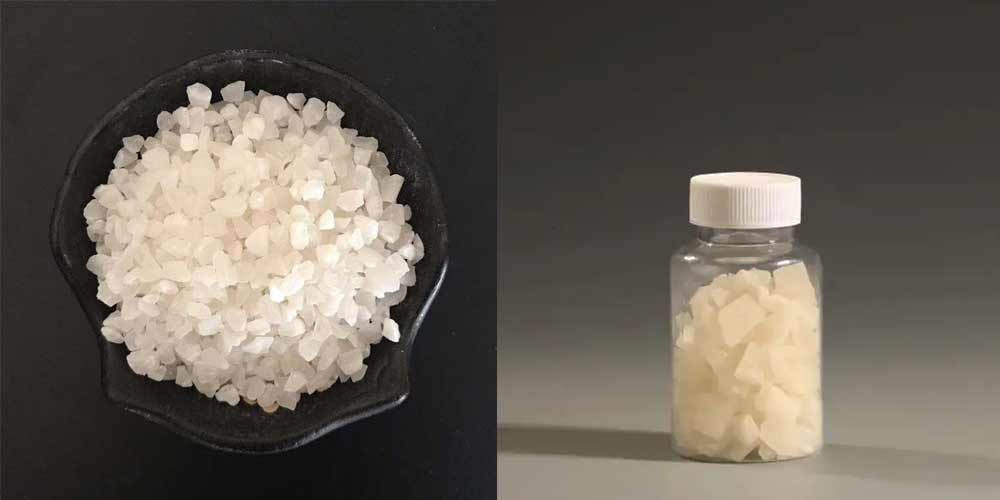အလူမီနီယမ်ဆာလဖိတ်Al2(SO4)3 အဖြစ် ဓာတုဗေဒအရ ကိုယ်စားပြုသည် ၊ သည် အဖြူရောင် ပုံဆောင်ခဲ အစိုင်အခဲဖြစ်ပြီး ရေသန့်စင်မှု လုပ်ငန်းစဉ်များတွင် အများအားဖြင့် အသုံးပြုလေ့ရှိသည်။ အလူမီနီယမ်ဆာလဖိတ်သည် ရေနှင့် ဓာတ်ပြုသောအခါ၊ ရေမော်လီကျူးများသည် ဒြပ်ပေါင်းကို ၎င်း၏ဒြပ်စင်အိုင်းယွန်းအဖြစ်သို့ ခွဲထုတ်သွားသည့် ဓာတုဗေဒတုံ့ပြန်မှုဖြစ်သည့် hydrolysis ကို ခံယူသည်။ ဤတုံ့ပြန်မှုသည် အမျိုးမျိုးသော အသုံးချမှုများတွင် အထူးသဖြင့် ရေသန့်စင်မှုတွင် အရေးပါသော အခန်းကဏ္ဍမှ ပါဝင်ပါသည်။
ဤတုံ့ပြန်မှု၏ အဓိကထုတ်ကုန်မှာ အလူမီနီယံ ဟိုက်ဒရော့စ် ရှုပ်ထွေးမှုဖြစ်သည်။ ဤရှုပ်ထွေးမှုသည် ရေသန့်စင်မှုတွင် အရေးပါသောကြောင့် ရေမှ အညစ်အကြေးများကို ဖယ်ရှားရာတွင် ကူညီပေးသည်။ အလူမီနီယမ် ဟိုက်ဒရော့ဇယ်လ် ကွန်ပေါင်းသည် မြင့်မားသော အားသွင်းသိပ်သည်းဆရှိပြီး ဖွဲ့စည်းသောအခါ၊ ၎င်းသည် ရွှံ့စေး၊ နုန်းနှင့် အော်ဂဲနစ်အရာများကဲ့သို့ ဆိုင်းငံ့ထားသော အမှုန်များကို ဖမ်းကာ ခဲသွားတတ်သည်။ ရလဒ်အနေဖြင့် ဤသေးငယ်သောအညစ်အကြေးများသည် ပိုမိုကြီးမားပြီး ပိုလေးသောအမှုန်များဖြစ်လာကာ ၎င်းတို့ကို ရေထဲမှအနည်ထိုင်ရန်ပိုမိုလွယ်ကူစေသည်။
တုံ့ပြန်မှုတွင်ထုတ်လုပ်သော sulfuric acid သည် အဖြေတွင်ကျန်ရှိနေပြီး စနစ်တစ်ခုလုံး၏အက်ဆစ်ဓာတ်ကို ပံ့ပိုးပေးသည်။ ရေသန့်စင်မှုလုပ်ငန်းစဉ်၏ သီးခြားလိုအပ်ချက်များပေါ်မူတည်၍ လိုအပ်သလို အချဉ်ဓာတ်ကို ချိန်ညှိနိုင်သည်။ pH ကိုထိန်းချုပ်ခြင်းသည် coagulation နှင့် flocculation လုပ်ငန်းစဉ်များ၏ထိရောက်မှုကိုပိုမိုကောင်းမွန်စေရန်အတွက်မရှိမဖြစ်လိုအပ်သည်။ ရေ၏ အယ်ကာလီဓာတ်ကိုလည်း လျော့နည်းစေသည်။ ရေကန်၏ အယ်ကာလီဓာတ် နည်းပါးပါက၊ ရေ၏ အယ်ကာလီဓာတ် တိုးလာစေရန် NaHCO3 ကို ပေါင်းထည့်ရန် လိုအပ်ပါသည်။
အလူမီနီယမ်ဆာလဖိတ်နှင့် ရေကြားတွင် တုံ့ပြန်မှုကို ရေသန့်စင်သည့်စက်ရုံများ၏ coagulation နှင့် flocculation အဆင့်များတွင် အသုံးများသည်။ Coagulation သည် ဆိုင်းငံ့ထားသော အမှုန်များ မတည်မငြိမ်ဖြစ်စေခြင်း ပါ၀င်ပြီး၊ flocculation သည် ဤအမှုန်များ စုစည်းမှုကို ပိုမိုကြီးမား၍ အလွယ်တကူ အနည်ထိုင်နိုင်သော flocs များအဖြစ်သို့ မြှင့်တင်ပေးပါသည်။ လုပ်ငန်းစဉ်နှစ်ခုစလုံးသည် အညစ်အကြေးများကို ဖယ်ရှားရန်နှင့် ရေရှင်းလင်းမှုအတွက် အရေးကြီးပါသည်။
ရေသန့်စင်မှုတွင် အလူမီနီယမ်ဆာလဖိတ်ကို အသုံးပြုခြင်းသည် ရေနေဂေဟစနစ်များတွင် အလူမီနီယမ် စုဆောင်းမှုဖြစ်နိုင်ချေကြောင့် သဘာဝပတ်ဝန်းကျင်ဆိုင်ရာ စိုးရိမ်မှုများကို မြင့်တက်လာစေကြောင်း သတိပြုရန် အရေးကြီးပါသည်။ အဆိုပါစိုးရိမ်မှုများကို လျော့ပါးစေရန်၊ သန့်စင်ထားသောရေတွင် အလူမီနီယံပါဝင်မှု စည်းမျဉ်းစံနှုန်းများနှင့် ကိုက်ညီကြောင်း သေချာစေရန် တိကျသောဆေးသောက်ခြင်းနှင့် စောင့်ကြည့်စစ်ဆေးခြင်းတို့သည် မရှိမဖြစ်လိုအပ်ပါသည်။
နိဂုံးချုပ်အားဖြင့်၊ အလူမီနီယမ်ဆာလဖိတ်သည် ရေနှင့် ဓာတ်ပြုသောအခါ၊ ၎င်းသည် hydrolysis ခံယူပြီး အလူမီနီယမ်ဟိုက်ဒရော့ဆိုဒ်နှင့် ဆာလဖူရစ်အက်ဆစ်တို့ကို ထုတ်လုပ်သည်။ ဤဓာတုတုံ့ပြန်မှုသည် ရေသန့်စင်မှုလုပ်ငန်းစဉ်များတွင် အဓိကကျပြီး အလူမီနီယမ်ဟိုက်ဒရောဆိုဒ်သည် ရေမှ ဆိုင်းငံ့ထားသော အညစ်အကြေးများကို ဖယ်ရှားရန် coagulant အဖြစ် လုပ်ဆောင်သည်။ သဘာဝပတ်ဝန်းကျင် ထိခိုက်မှု အနည်းဆုံးဖြစ်အောင် ထိရောက်သော ရေသန့်စင်မှု သေချာစေရန်အတွက် မှန်ကန်သော ထိန်းချုပ်မှုနှင့် စောင့်ကြည့်မှု လိုအပ်ပါသည်။
စာတိုက်အချိန်- မတ်လ-၀၅-၂၀၂၄


